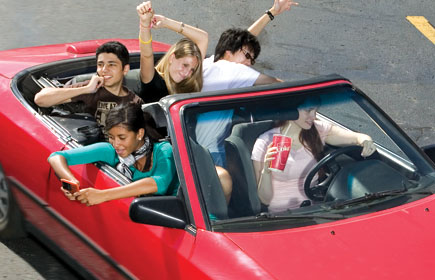
Adolescent Distracted Driving: Tips for Parents
by Thomas Ray, Poe Center Senior Director of Educational Programming
Most teen drivers do not text and drive. As a matter of fact, in a recently released (2014) study conducted by UNC’s Highway Safety Research Center only 6.7% of observations included any use of an electronic device by an adolescent driver (including holding phone to ear, talking hands free, and texting or suspected texting). For this study, g-force triggered an in-vehicle camera to collect a short video clip capturing data prior to and following the sudden velocity change. Almost as frequently, the trigger was related to adjusting vehicle controls (6.2%). Grooming (3.8%), eating or drinking (2.8%), and reaching for an object in the vehicle (2.5%) were the other most common driver behaviors.
 But get this – passenger behaviors were big time distractions for teen drivers. When passengers were present, loud conversations were distractions in 12.6% of the observations! Horseplay was present in 6.3% of the observations with the driver participating in the horseplay in over half of those (3.7%) [1].
But get this – passenger behaviors were big time distractions for teen drivers. When passengers were present, loud conversations were distractions in 12.6% of the observations! Horseplay was present in 6.3% of the observations with the driver participating in the horseplay in over half of those (3.7%) [1].
So what’s the big deal? According to a national study analyzing accidents for drivers of ages 15–18, “recognition errors” were involved in 46.3% of teen driver involved serious crashes. These errors include inadequate surveillance (21.3%), internal distraction (13.9%), external distraction (6%), and inattention (2%) along with other errors [2]. We spend a lot of time talking about teen distractions with a focus on texting, but we probably need to spend more time focusing on educating passengers about the importance of their behavior in the vehicle with inexperienced drivers.
In terms of policy, we should commend our legislators for the graduated driver’s license that allows inexperienced drivers to take the time to move from a more controlled learning setting to more independence as the driver gains experience on the road. However, parents of adolescent or inexperienced drivers need to take the time to talk not only with their teen driver, but with the driver’s siblings and others who may be passengers. Here are a few tips for parents, passengers of inexperienced drivers and drivers:
- Parents, talk with your teen drivers about the dangers of distracted driving. Be a model of the behavior you want from your teen.
- Put your electronic device away before you put the car in gear. Turn the phone off and place it in the trunk or glove compartment.
- Consider installing an app that automatically replies to texts and calls. Some apps to consider include txtBlocker, CellSafety, Textecution, and iZUP.
- Limit the number of passengers in the vehicle with a teen driver. In addition to following the graduated license process, make sure that each passenger understands the need to avoid loud conversations and help the driver keep her or his eyes on the road.
- Remind drivers and passengers that horseplay needs to take place outside of the car. Horseplay just doesn’t belong inside a moving vehicle.
- Passengers should offer to navigate, adjust controls, and reply to texts or calls for the driver as appropriate.
- EVERYONE in the vehicle should be in a seat belt. Unbelted passengers – even in the back seat – can cause fatal injuries for other passengers in the case of a vehicle crash.
References
[1] Foss RD, Goodwin AH. Distracted driver behaviors and distracting conditions among adolescent drivers: Findings from a naturalistic driving study. Journal of Adol Health 2014; 54:S50 – S60.
[2] Curry AE, Hafetz J. Kallan MJ, et al. Prevalence of teen driver errors leading to serious motor vehicle crashes. Accid Anal Prev 2011; 43:1285 – 1290.
